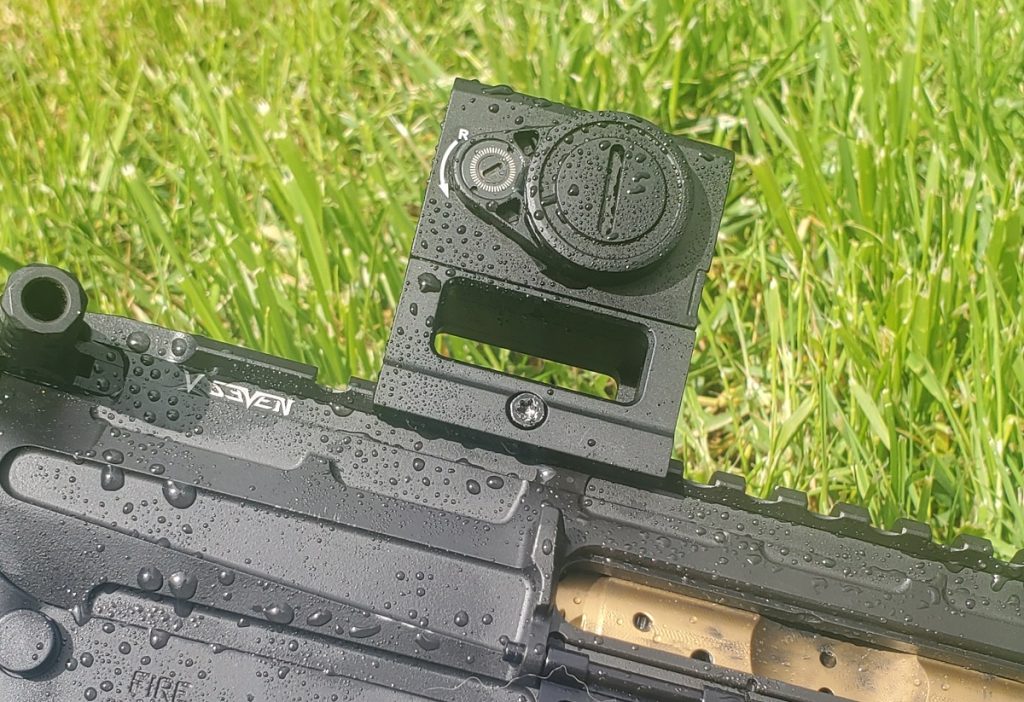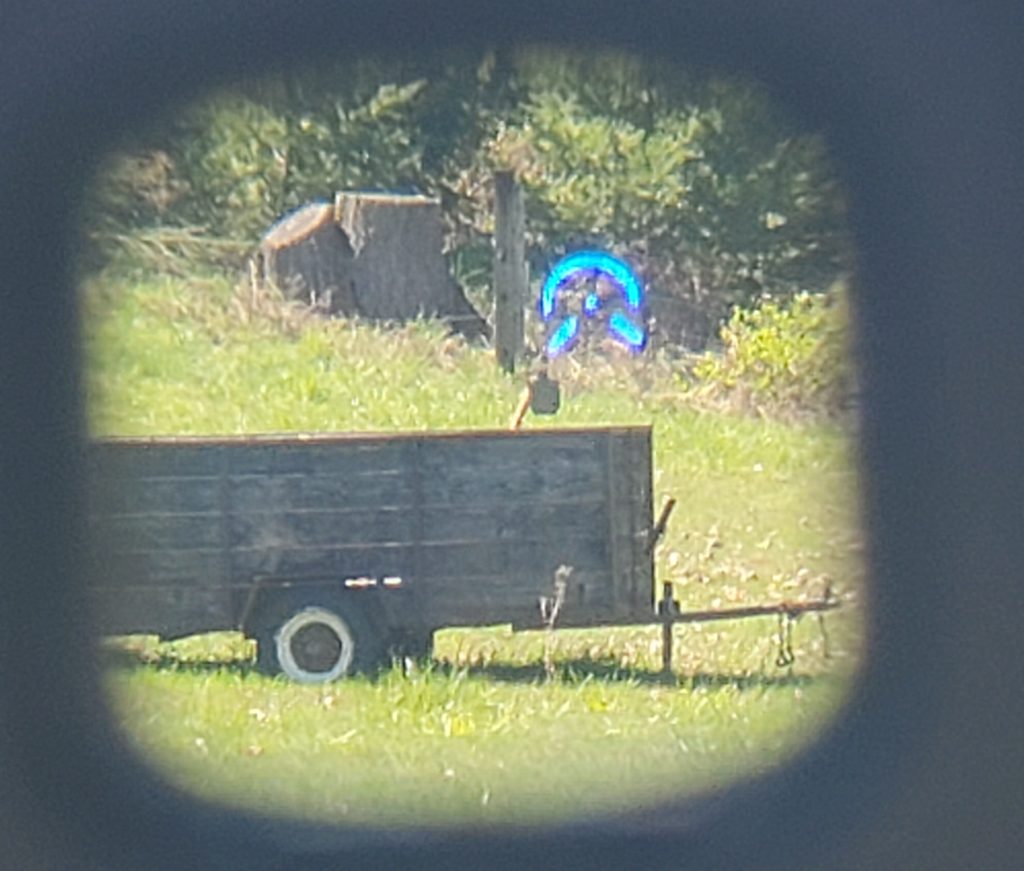
I first reviewed a Lucid optic back in 2017. At the time, there were a ton of new companies hitting the market with a pretty similar lineup of products. The darwinian nature of capitalism meant I could expect 80% would be bankrupt in a year or two, and I was correct. Lucid however, stuck around and not only survived, but has thrived. Seven years later, they’re still here, dropping new optics.
Specifically, the Wyoming-based Lucid sent me the E7 “Micro” Enclosed Reflex Sight – Blue. Why blue? Read on.

Tech Specs:
- Finish: Matte Black
- Material: 7075 Aluminum
- Magnification: 1x
- Objective Lens Diameter: 21mm
- Reticle: M5
- Illumination Color: Blue
- Emitter Type: Enclosed
- Battery Life: 50,000 hours
- Fogproof?: Yes
- Length: 1.78″
- Weight: 2.65oz
- Footprint: Aimpoint ACRO
- Mount: Picatinny/ACRO adaptor mount included for rifle use
- Shake Awake
- 90 MOA Windage and Elevation Adjustment
- Designed and Engineered in Wyoming
Feeling Blue?
Lucid advertises that the human eye is more sensitive to blue light that any other color. Blue provides a clean reticle edge, a calming circadian effect and says exposure to blue light reduces stress levels.
So… blue. We started with red, and eventually tried green as well. Blue stacks up well enough. I can’t speak to the “calming, circadian rhythm” effect, shooting always makes me happy. The color is easy enough to pick up and contrasts well with the usually brown and green backdrops I shoot against. Blue, however, washes out more easily when placed against a white background, which gave me a little trouble that you’ll hear about later.
Construction and Design
The E7 enclosed emitter sight is made of 7075 aluminum, a pretty tried and true choice. The CR2032 battery slot is on the right (starboard) side, and is no more than finger tight. The windage and adjustment screws are on the right side and top, respectively.
Brightness adjustment buttons are on the left (port) side. They’re easy enough to get at with naked fingers, but I’m not looking forward to adjusting brightness with gloves in winter.

The E7 is compatible with the ACRO handgun mounting footprint, but I’m using the included Picatinny riser mount to strap this optic to a V7 Weapon Systems Sovereign AR.
The E7 is also listed as IPX7 rated against a water-based invasion.

Range Days
You hit the range, rifle in hand. New optic mounted, mags loaded, targets set. First up: zeroing. This was the hardest part of range day numero uno. I’d picked an unseasonable sunny spring day here in Oregon, and even on the sight’s brightest setting, I struggled to pick up the blue M5 reticle against the white cardboard target backing. I had to construct a makeshift tower to the south of the target to provide some shade.
Once I had rounds on paper, I made an adjustment. I think the elevation/windage is designed to be adjusted with a tiny flathead screwdriver, because trying to use the usual .223 casing casing method was brutal. I’d love to see a different option here in the future.
Finally, with the rifle was zeroed, I moved on to steel.
When I wasn’t aiming at a bright white cardboard target perfectly positioned to reflect the sun’s blinding rays, the E7 proved plenty bright. With grass and forest backgrounds, the reticle showed nicely and provided an ample aiming reference.
I went through six or seven mags that day, running a few of my favorite drills at 25, 50, and 100 yards. Despite a few initial struggles zeroing, the rest of the day went well.

Extended Use
I’ve had this optic for a few months beyond that first range day. Here are a few things I think.
- One son, who is colorblind, absolutely loves the E7’s blue reticle. Red and brown blend together, but blue stands out for him. This is his go-to optic now, and Lucid likely has a lifelong customer in him.
- I’m now a “shake awake” guy. I was slow to adopt, but the Lucid E7’s 50,000 hour battery life make this a worry-free feature. Grab it and go.
- I still don’t like the adjustment dials for windage and elevation, but they don’t need to be adjusted often.
- I haven’t run into any more brightness issues. The M5 reticle stands out well against anything other than bright white cardboard in direct sunlight.
- The reticle is crisp and easy to see. Holdovers at extended ranges are a lot easier than with just a dot, but obviously less precise than with more complex reticles. It’s a good jack-of-all-trades design.
- A thousand rounds isn’t an exhaustive torture test by any stretch of the imagination, but the E7 is holding zero and functioning as intended.
- I don’t have 50,000 hours to test battery life — that’s almost six years — but it’s been on for a few months and it’s still working fine. No battery drain issues.

Bottom Line
Lucid has survived and thrived (surthrived?) through a tumultuous and crowded time in the optics industry that has seen even huge names like Nikon shutter their firearms optics brand. Lucid has done this by making optics that are tough, feature-packed, and come in at a reasonable price. Lucid also offers a limited lifetime warranty against manufacturer defects and normal wear and tear.
I’m digging the E7. Once I got past my dislike of the windage/elevation adjustments, the rest of my months with this optic have been positive. I like the Lucid E7 enough to keep it on on of my guns going forward.
With a factory price of $299, and a street price of $239.99, the Lucid E7 is worth checking out.
Jens “Rex Nanorum” Hammer, @Rexnanorum

6 Responses
Well, from the one pic it appears you are a left handed shooter but I’ll not hold that against you this time.
😁
Yeah, I looked at this Lucid optic too. Its pretty much as you say, although, the pic you have with the reticle – for those who wonder, the reticle looks a lot nicer than what that pic shows.
Interesting, my image got flipped somehow! No, I’m primarily a righty, though I can shoot left handed well enough. The gun is a right hander though.
And yes I agree, the reticle doesn’t show up well in the photo, it’s better in person.
“Lucid advertises that the human eye is more sensitive to blue light that any other color.”
Odd, I could have sworn green was the human eye’s most sensitive color, and by a fairly wide margin.
Blue light to my eyes is kinda blurry, indistinct. I’ll have to play with one of these to find out…
So what’s the most sensitive color to the human eye with deuteroanopia?
Red and green just look like an illuminated dot to me. Is the blue supposed to be better? The pic makes it look like a white light to me.
One of my boys has deuteranopia. He sees a red dot as grayish.. but said “bright blue” in regards to this Lucid optic
“Lucid advertises that the human eye is more sensitive to blue light than any other color.”
That’s true and not true at the same time.
Basically and briefly to avoid a longer explanation – its a matter of physics: The human eye is not very good at filtering blue light. This means that of light colors more blue light can enter the eye than other colors. This is basically where the claim comes from that “the human eye is more sensitive to blue light that any other color”. In reality its not a ‘sensitivity’ in terms of seeing blue light better, its a ‘sensitivity’ in terms of the eye not filtering blue light very well. Because the human eye does not filter blue light very well, a point source (e.g. a blue light bulb, a blue reticle in a dot sight, etc…) of blue light actually overwhelms vision acuity for light color and depending on how intense the blue light is may seem to be perceived as being seen better but in reality its our brains playing tricks on us by trying to equate the blue light to a ‘normal’ color for focus.
Because the blue component of the light is basically not filtered it can be said “the human eye is more sensitive to blue light than any other color”, but in terms of eye vision focus and sensitivity it doesn’t mean you can actually see blue light better than other colors of light. And of course if you have a ‘red/green’ color blindness issue or another ‘color vision or vision’ issue – because blue light is basically not filtered by the eye a person may perceive blue light better.
Virtually all visible blue light passes through the cornea and lens and reaches the retina, for other colors the light is filtered through the cornea and lens before it reaches the retina. This in reality is a problem. Because blue light scatters more easily than other visible light, it’s not as easily focused. This is where our brains start playing tricks on us, by making us think we are focused as it tries to equate the blue light to a ‘normal’ color for focus but here again it depends on the intensity of the blue light as the less intense the less our eyes are overwhelmed.
However, some wavelengths of blue light are better for natural eye focus and can be seen better in terms of focus. One of these is blue-turquoise light. If you take a look at the pic with the article, the reticle, Lucid calls this blue but in reality its a blue-turquoise’ish which just so happens to be in the blue light wavelength that the eye can almost completely naturally focus on and the brain does the rest with its tricks.
yes, I left some stuff out for the sake of brevity, especially the parts where the physics come into play, so some it might seem to be confusing. But in terms of the claim “the human eye is more sensitive to blue light than any other color” – just remember, its not ‘sensitive’ in terms of actual natural vision acuity but rather its ‘sensitive’ in terms of blue light not being filtered by the eyes naturally thus more blue light reaches the retina that that of other colors – but it does not mean vision acuity is actually better with blue light because more of it reaches the retina, or in other words more does not always mean better.
In terms of vision ‘sensitivity’ for eyes vision perception and actual real focus for point sources the best light color is green light.